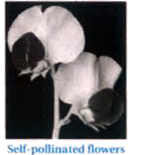What is pollination? Describe its typesSolution in Gujrati
Male and female gemates in flowering plants are produced in the pollen grain and embryo sac respectively. As both types of gametes are non motile they have to be brought together for fertilisation to occur. Pollination is the mechanism to achieve this objective. Transfer of pollen grains (shed from the anther) to the stigma of a pistil is termed as pollination. Flowering plants have evolved an amazing array of adaptations to achieve pollination. Kinds of pollination: Depending on the source of pollen, pollination can be divided into three types: (a) Autogamy (b) Geitonogamy ( c) Xenogamy.
(a) Autogamy: In this type pollination is achieved within the same flower. Here there is transfer of pollen grains from the anther to the stigma of the same flower. In a normal flower which opends and exposes the anthers and the stigma, complete autogamy is rather rare. Autogamy in such flowers requires synchrony in pollen released and stigma receptivity and also, the anthers and the stigma shoudl lie close to each other so that self pollination can occur. Autogamy normally becomes possible in bisexual flowers.

In flowers possessing autogamy anther and stigma, both mature at the same time. So pollination becomes possible eg. In Apeaceac, Lameacea and cacateceac family self pollination takes place. DUe to movement of style, stigma comes near to anther.
Chasmogamous flowers and cleistogamous flowerss: Some plants such as viola (common Pansy), oxalis and commelina produce two types of flowers.
(i) Chasmogamous flowers: These flowers are similar to flowers of other species with exposed anthers and stigma, eg.g commelina.
(ii) Cleistogamous: These flowers do not open at all. In such flowers the anthers and stigma lie close to each other. When anthers dehisce in the flower buds. Pollen grains come in contact with the stigma to effect pollination. Thus cleistogamous flowers are invariably autogamous as there is no chance of crosss-pollen landing on the stigma. Cleistogamous flowers produce assured seed set even in the absence of pollinators

(b) Geltonogamy: Here there is transfer of pollen grains from the anther to the stigma of another flower of the same plant. Although geitonogamy is functionally cross-pollination involving a pollinating agents, genetically it is similar to autogamy since the pollen grains come from the same plant.
(c ) Xenogamy: Here there is transfer of pollen grains from anther to the stigma of a different plant. This is the only type of pollination which during pollination brings genetically different types of pollen grains to the stigma. Cross pollination which occurs in species is called xenogamy. This is such type of pollination which brings genetically different types of pollen grains to the stigma. The offsprings produced by this become hybrid. Cross pollination is possible only in unisexual flowers. Due to cross pollination, cross fertilation takes place and advantages of genetic recombination is obtained

Topper's Solved these Questions
- SEXUAL REPRODUCTION IN FLOWERING PLANTSBOOK - KUMAR PRAKASHANCHAPTER - SEXUAL REPRODUCTION IN FLOWERING PLANTSEXERCISE - Section -A (Double Fertilization)
1 Video
- SEXUAL REPRODUCTION IN FLOWERING PLANTSBOOK - KUMAR PRAKASHANCHAPTER - SEXUAL REPRODUCTION IN FLOWERING PLANTSEXERCISE - Section -A (Post Fertillisation: Structures And Events)
5 Videos
- SEXUAL REPRODUCTION IN FLOWERING PLANTSBOOK - KUMAR PRAKASHANCHAPTER - SEXUAL REPRODUCTION IN FLOWERING PLANTSEXERCISE - Section -A (Flower-A Fascinating Organ of Angiosperms)
3 Videos
- REPRODUCTIVE HEALTH BOOK - KUMAR PRAKASHANCHAPTER - REPRODUCTIVE HEALTH EXERCISE - Section - F Multiple Choice Questions (MCQs)
102 Videos
- STRATEGIES FOR ENHANCEMENT IN FOOD PRODUCTIONBOOK - KUMAR PRAKASHANCHAPTER - STRATEGIES FOR ENHANCEMENT IN FOOD PRODUCTIONEXERCISE - SECTION -F (Multiple Choice Questions (MCQs)) (MCQs Asked In Competition Exam)
63 Videos
Similar Questions
Explain double fertilisation angiosperms
View SolutionWhat is endosperm? Describe types of endosperm
View SolutionMention social, religious and cultural value of the flowers
View SolutionWhich problems arise due to uncontrolled population growth ?
View SolutionPollen-grains of a plant whose 2n = 28 are cultured to get callus by tissue culture method. What would be the number of chromosomes in the cells of the callus?
View Solutionपरागण क्या है ? पुष्पी पादपों में होने वाले विभिन्न प्रकार के परागण का वर्णन कीजिए । जीवीय परागण कर्मको (pollinating agents ) के बारे में उल्लेख कीजिए ।
View Solutionपर-परागण किसे कहते हैं? पर-परागण की विभिन्न विधियों का वर्णन कीजिए तथा इसके महत्त्व को समझाइए।
View Solutionपरागण क्या है ? परागण का वर्णन कीजिए ।
View Solutionपर-परागण किसे कहते है ? इसके महत्वो का वर्णन कीजिए |
View Solutionपर-परागण हेतु पुष्पों में पाए जाने वाले दो अनुकूलन बताइये |
View Solutionपर-परागण हेतु पुष्पों में पाए जाने वाले दो अनुकूलन बताइये |
View SolutionWhat is pollination ? Mention its types.
View SolutionWhat is cross - pollination ? What are its types ?
View SolutionDescribe different types of cross pollination in plants.
View SolutionWhat is meant by pollination ? Describe its various types along with names of various pollinating agents.
View Solution